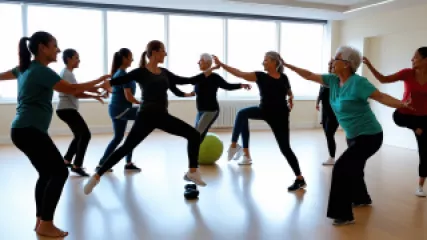Why Dance Movement Therapy Is Essential for Mental Health
Why Dance Movement Therapy Is Essential for Mental Health
As a mental health professional, I've witnessed firsthand the transformative power of dance movement therapy (DMT) in improving overall well-being and addressing a range of mental health concerns. In a world where the demands of modern life can often feel overwhelming, the integration of dance and movement into therapeutic practices has emerged as a profoundly impactful approach to supporting individuals on their journey towards mental and emotional resilience.
At the core of DMT lies the understanding that the mind and body are intrinsically connected. By engaging the physical aspect of our being through intentional movement, we unlock a profound avenue for self-expression, emotional processing, and the cultivation of a deeper sense of self-awareness. This holistic approach to mental health care recognizes that the way we move, carry ourselves, and engage with our bodies can have a profound impact on our psychological and emotional well-being.
Unlocking the Power of Movement
In a world that often prioritizes intellectual and sedentary pursuits, the importance of physical expression cannot be overstated. Dance movement therapy provides a unique opportunity for individuals to reconnect with their bodies, to move in ways that feel authentic and liberating, and to harness the transformative power of embodied experience.
Through DMT, clients are encouraged to explore a wide range of movement modalities, from fluid and graceful dance forms to more expressive and improvisational movements. This dynamic engagement with the body allows for the release of pent-up emotions, the processing of trauma or stress, and the cultivation of a deeper sense of self-acceptance and body positivity.
As a dance movement therapist, I've witnessed the profound impact of this approach time and time again. Clients who initially felt disconnected from their bodies or burdened by feelings of anxiety or depression have emerged from DMT sessions with a renewed sense of vitality, self-awareness, and emotional regulation.
Addressing Mental Health Holistically
One of the key advantages of dance movement therapy is its ability to address mental health concerns from a multidimensional perspective. Unlike traditional talk therapy, which primarily focuses on the cognitive and verbal aspects of the human experience, DMT encompasses the entire spectrum of our being, integrating the physical, emotional, and psychological realms.
Through the lens of DMT, mental health challenges are not viewed as isolated issues, but rather as deeply intertwined with our bodily experiences and the ways in which we move through the world. By addressing the mind-body connection, DMT practitioners can help clients develop a more nuanced understanding of their mental health, identifying and addressing the root causes of their struggles rather than simply treating the symptoms.
Whether an individual is grappling with anxiety, depression, trauma, or a range of other mental health concerns, the incorporation of dance and movement into the therapeutic process can yield profound and lasting results. By tapping into the innate wisdom of the body, DMT empowers clients to access and process their emotions in a tangible, embodied way, fostering greater self-awareness, emotional regulation, and ultimately, a enhanced sense of overall well-being.
The Transformative Power of Connection
In addition to the physical and psychological benefits of dance movement therapy, the modality also holds immense power in its ability to foster meaningful connections and community among participants. Dance, by its very nature, is a communal experience – one that often transcends language and cultural barriers, uniting individuals through the shared language of movement.
Within the context of DMT sessions, clients are encouraged to engage in group activities, collaborative improvisation, and shared exploration of movement. This collaborative approach not only helps to build trust and empathy among participants but also provides a sense of belonging and social support that can be transformative for individuals struggling with isolation or disconnection.
I've witnessed the power of this communal aspect of DMT firsthand, as clients who may have initially felt hesitant or self-conscious gradually open up and connect with their peers through the shared experience of movement. The sense of camaraderie and support that emerges within these sessions can be truly remarkable, serving as a powerful antidote to the often-isolating nature of mental health challenges.
Empowering Clients Through Self-Expression
One of the most profound aspects of dance movement therapy is its ability to empower clients through the act of self-expression. In a world that can often feel overwhelming and constrained, the freedom to move, to explore, and to authentically express oneself can be a profoundly liberating experience.
Within the safe and supportive environment of a DMT session, clients are encouraged to let go of inhibitions, to move in ways that feel natural and authentic to them, and to tap into the innate wisdom of their bodies. This process of self-discovery and embodied expression can be transformative, allowing individuals to access and process emotions that may have been previously buried or suppressed.
As a dance movement therapist, I've witnessed clients who initially felt timid or self-conscious gradually shed those inhibitions, embracing their own unique movement styles and finding a newfound sense of confidence and self-acceptance. This empowerment can have a ripple effect, spilling over into other areas of their lives and empowering them to live more authentically and with greater emotional resilience.
The Versatility of Dance Movement Therapy
One of the truly remarkable aspects of dance movement therapy is its versatility and applicability across a wide range of mental health concerns and populations. From individuals struggling with anxiety or depression to those coping with the aftermath of trauma or chronic illness, DMT can be a powerful tool for promoting healing, self-discovery, and overall well-being.
In working with clients of all ages and backgrounds, I've seen the profound impact of DMT in addressing a variety of mental health challenges. For children and adolescents, DMT can be particularly impactful, providing a nurturing and supportive environment for emotional expression, conflict resolution, and the development of social-emotional skills.
Similarly, for older adults, DMT can be a valuable tool for maintaining cognitive function, improving physical mobility, and fostering a greater sense of connection and community. And for those grappling with the emotional and psychological impacts of chronic illness or disability, DMT can offer a means of reclaiming a sense of embodied agency and control.
Regardless of the specific mental health concern or demographic, the core principles of dance movement therapy – the integration of the mind and body, the emphasis on self-expression, and the power of communal connection – remain steadfast in their ability to promote healing and growth.
Integrating DMT into Mental Health Care
As the field of mental health care continues to evolve, the integration of dance movement therapy into mainstream treatment modalities is becoming increasingly crucial. In a world that often prioritizes quick fixes and symptom management, DMT offers a refreshingly holistic approach to supporting individuals on their journeys towards mental and emotional well-being.
By recognizing the inherent connection between the physical, emotional, and psychological realms, dance movement therapy provides a unique and powerful complement to traditional talk therapy, medication management, and other mental health interventions. Through its ability to address the root causes of mental health challenges, DMT empowers clients to develop a deeper understanding of themselves and the factors that contribute to their overall well-being.
As a dance movement therapist, I firmly believe that the incorporation of this modality into mainstream mental health care is not only beneficial but essential. By expanding the reach and accessibility of DMT, we can help to destigmatize mental health challenges, empower individuals to take an active role in their own healing, and foster a more holistic, comprehensive approach to supporting mental and emotional resilience.
The Future of Dance Movement Therapy
As the world continues to grapple with the mental health impacts of the COVID-19 pandemic, the need for accessible and engaging mental health interventions has never been more pressing. In this context, the role of dance movement therapy in supporting individual and community well-being has become increasingly vital.
Through the innovative integration of virtual dance sessions for wellness and dance as therapy online, DMT practitioners have been able to reach a wider audience and provide much-needed support to individuals who may have been isolated or disconnected from traditional in-person services. These virtual dance movement therapy online sessions have demonstrated the versatility and adaptability of the modality, allowing clients to engage in the transformative power of movement and embodied expression from the comfort and safety of their own homes.
As we look towards the future of mental health care, the continued growth and expansion of dance movement therapy will undoubtedly play a crucial role. By empowering individuals to reconnect with their bodies, process emotions through movement, and cultivate a deeper sense of self-awareness and community, DMT offers a uniquely holistic and impactful approach to supporting mental health and overall well-being.
In my role as a dance movement therapist, I am honored to witness the profound and often life-changing impact of this modality on the individuals and communities I serve. From the joyful and liberating moments of pure self-expression to the profound breakthroughs in emotional processing and resilience-building, the power of dance and movement to transform lives is undeniable.
As we continue to navigate the complexities of modern life and the ever-evolving landscape of mental health care, I remain steadfast in my conviction that dance movement therapy is essential for supporting the holistic well-being of individuals and communities. By embracing the transformative potential of embodied experience, we can unlock new pathways for healing, growth, and the cultivation of a more vibrant, resilient, and connected world.
Key takeaways:
- Dance movement therapy (DMT) is a powerful approach to mental health care that integrates the mind-body connection.
- DMT empowers clients to express themselves through movement, fostering emotional processing, self-awareness, and overall well-being.
- The communal aspect of DMT can help build trust, empathy, and a sense of belonging, serving as a powerful antidote to isolation and disconnection.
- DMT is versatile and applicable across a wide range of mental health concerns and populations, from children and adolescents to older adults and those with chronic illness or disability.
- The integration of DMT into mainstream mental health care is essential, as it offers a holistic approach to supporting individual and community well-being.
- The COVID-19 pandemic has highlighted the adaptability of DMT, with virtual dance sessions for wellness and dance as therapy online providing crucial support during times of isolation.
- The future of mental health care will be shaped by the continued growth and expansion of dance movement therapy, empowering individuals to reconnect with their bodies, process emotions, and cultivate resilience.
As a dance movement therapist, I am deeply passionate about the transformative power of this modality in supporting mental health and overall well-being. Dance and movement have the unique ability to transcend language, culture, and personal barriers, uniting individuals through the shared experience of embodied expression. Through the integration of DMT into mental health care, we can foster a more holistic, empowering, and community-driven approach to supporting the well-being of individuals and communities alike.
In a world that often feels increasingly disconnected and overwhelming, the power of dance movement therapy to reconnect us with our bodies, our emotions, and our shared humanity is truly remarkable. By embracing the versatility and adaptability of this modality, we can unlock new pathways for healing, growth, and the cultivation of a more vibrant, resilient, and joyful future.






